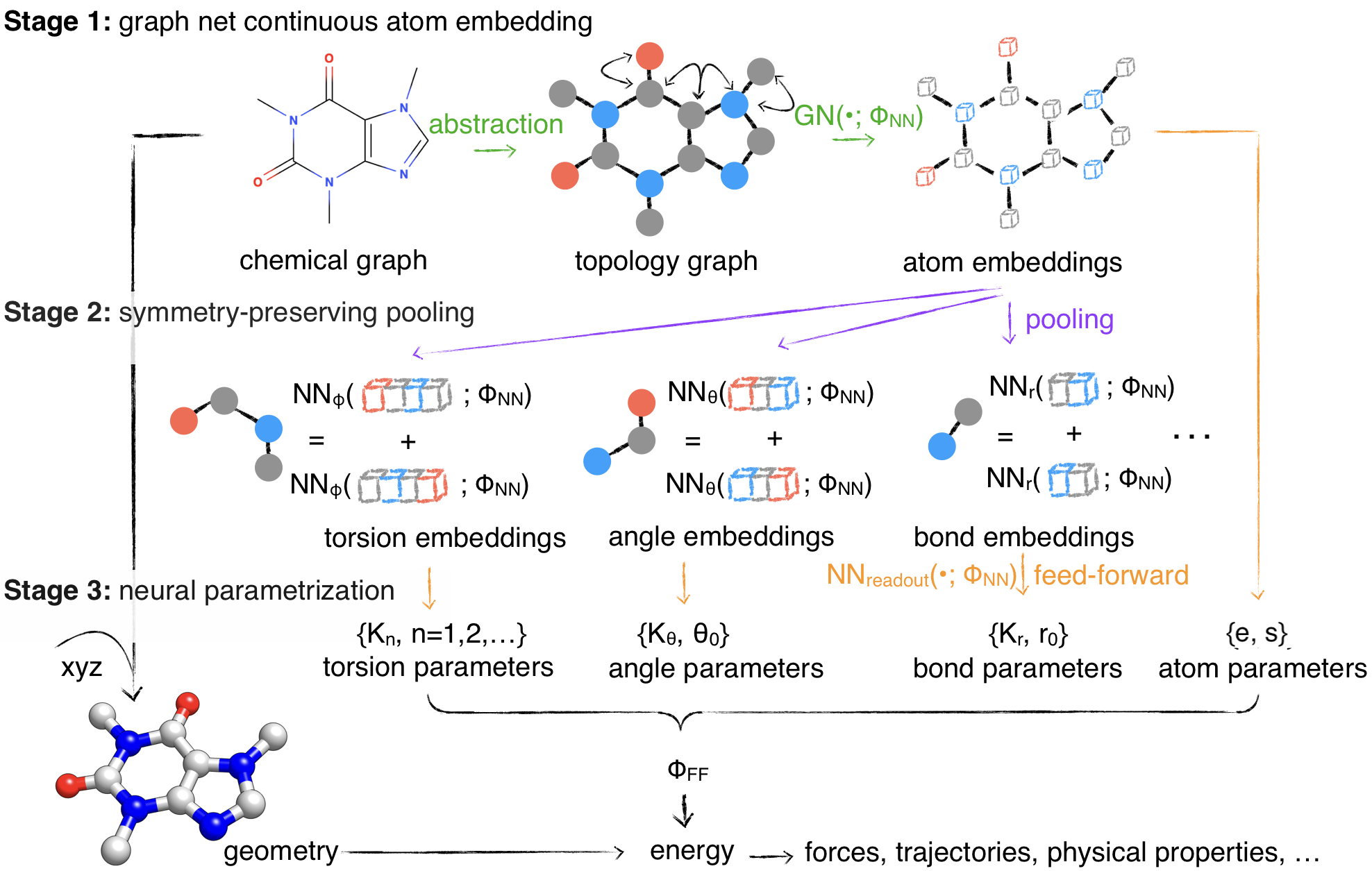Source code for Wang Y, Fass J, and Chodera JD "End-to-End Differentiable Construction of Molecular Mechanics Force Fields."
Documentation: https://docs.espaloma.org
Molecular mechanics (MM) potentials have long been a workhorse of computational chemistry. Leveraging accuracy and speed, these functional forms find use in a wide variety of applications in biomolecular modeling and drug discovery, from rapid virtual screening to detailed free energy calculations. Traditionally, MM potentials have relied on human-curated, inflexible, and poorly extensible discrete chemical perception rules atom types for applying parameters to small molecules or biopolymers, making it difficult to optimize both types and parameters to fit quantum chemical or physical property data. Here, we propose an alternative approach that uses graph neural networks to perceive chemical environments, producing continuous atom embeddings from which valence and nonbonded parameters can be predicted using invariance-preserving layers. Since all stages are built from smooth neural functions, the entire process---spanning chemical perception to parameter assignment---is modular and end-to-end differentiable with respect to model parameters, allowing new force fields to be easily constructed, extended, and applied to arbitrary molecules. We show that this approach is not only sufficiently expressive to reproduce legacy atom types, but that it can learn and extend existing molecular mechanics force fields, construct entirely new force fields applicable to both biopolymers and small molecules from quantum chemical calculations, and even learn to accurately predict free energies from experimental observables.
We recommend using mamba which is a drop-in replacement for conda and is much faster.
$ mamba create --name espaloma -c conda-forge "espaloma=0.3.2"Note: If you are using a Mac with a M1/M2 chip, you will need to install and run espaloma using Rosetta by using the following commands:
CONDA_SUBDIR=osx-64 mamba create --name espaloma -c conda-forge "espaloma=0.3.2"
mamba activate espaloma
mamba config --env --set subdir osx-64This will ensure that any other packages installed in the espaloma will also use Rosetta.
# imports
import os
import torch
import espaloma as esp
# define or load a molecule of interest via the Open Force Field toolkit
from openff.toolkit.topology import Molecule
molecule = Molecule.from_smiles("CN1C=NC2=C1C(=O)N(C(=O)N2C)C")
# create an Espaloma Graph object to represent the molecule of interest
molecule_graph = esp.Graph(molecule)
# load pretrained model
espaloma_model = esp.get_model("latest")
# apply a trained espaloma model to assign parameters
espaloma_model(molecule_graph.heterograph)
# create an OpenMM System for the specified molecule
openmm_system = esp.graphs.deploy.openmm_system_from_graph(molecule_graph)If using espaloma from a local .pt file, say for example espaloma-0.3.2.pt,
then you would need to run the eval method of the model to get the correct
inference/predictions, as follows:
import torch
...
# load local pretrained model
espaloma_model = torch.load("espaloma-0.3.2.pt")
espaloma_model.eval()
...The rest of the code should be the same as in the previous code block example.
Below is a compatibility matrix for different versions of espaloma code and espaloma models (the .pt file).
| Model 🧪 | DOI 📝 | Supported Espaloma version 💻 | Release Date 🗓️ | Espaloma architecture change 📐? |
|---|---|---|---|---|
espaloma-0.3.2.pt |
0.3.1, 0.3.2 | Sep 22, 2023 | ✅ No | |
espaloma-0.3.1.pt |
0.3.1, 0.3.2 | Jul 17, 2023 | ||
espaloma-0.3.0.pt |
0.3.0 | Apr 26, 2023 |
Note
espaloma-0.3.1.pt and espaloma-0.3.2.pt are the same model.
An example of using espaloma to parameterize small molecules in relative alchemical free energy calculations is provided in the scripts/perses-benchmark/ directory.
espaloma/core code for graph-parametrized potential energy functions.graphs/data objects that contain various level of information we need.graph.pybase modules for graphs.molecule_graph.pyprovide APIs to various molecular modelling toolkits.homogeneous_graph.pysimplest graph representation of a molecule.heterogeneous_graph.pygraph representation of a molecule that contains information regarding membership of lower-level nodes to higher-level nodes.parametrized_graph.pygraph representation of a molecule with all parameters needed for energy evaluation.
nn/neural network models that facilitates translation between graphs.dgl_legacy.pyAPI to dgl models for atom-level message passing.
mm/molecular mechanics functionalities for energy evaluation.i/energy terms used in Class-I force field.bond.pybond energyangle.pyangle energytorsion.pytorsion energynonbonded.pynonbonded energy
ii/energy terms used in Class-II force field.coupling.pycoupling termspolynomial.pyhigher order polynomials.
This software is licensed under MIT license.
Copyright (c) 2020, Chodera Lab at Memorial Sloan Kettering Cancer Center and Authors: Authors:
- Yuanqing Wang
- Josh Fass
- John D. Chodera
